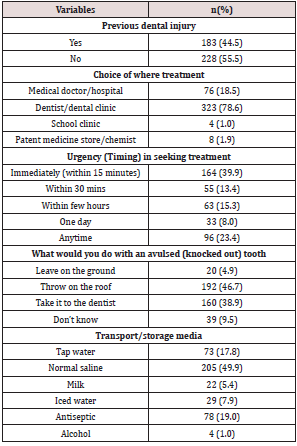
Lupine Publishers Group
Lupine Publishers
Menu
ISSN: 2637-6636
Research Article(ISSN: 2637-6636) 
An Assessment of Emergency Care Following Tooth Avulsion Among A Selected Population of Nigerian School Children Volume 3 - Issue 5
Joycelyn O Eigbobo* and Sylvia S Etim
- Department of Child Dental Health, Faculty of Dentistry, University of Port Harcourt, Nigeria
Received: February 11, 2020; Published: February 20, 2020
*Corresponding author: Joycelyn O Eigbobo, Department of Child Dental Health, Faculty of Dentistry, College of Health Sciences, University of Port Harcourt, Port Harcourt, Rivers State, Nigeria
DOI: 10.32474/IPDOAJ.2020.03.000174
Abstract
Aim: To assess the knowledge of school children on the first aid administered after traumatic tooth avulsion.
Methods: A structured questionnaire was used to obtain information from children of six primary and six secondary schools in Port Harcourt, Nigeria. Information elicited included respondents’ socio-demographics, exposure to dental trauma and knowledge on emergency care for tooth avulsion. Data collected was analysed using SPSS Version 22 and level of significance was set at p <0.05.
Results:There were 411pupils; 194 males and 217 females with a mean age of 12.5 (±2.6) years. One hundred and eighty-three
(44.5%) had previous dental injuries. Three hundred and twenty-three (78.6%) would seek treatment in dental clinic after tooth
avulsion. Only 16 (3.9%) would replace the tooth in its socket, 160 (38.9%) would take it to the dental clinic and 192 (46.7%) will
throw the tooth on a roof top. Only 164 (39.9%) would seek immediate treatment. Twenty-two (5.4%) will use milk as storage/
transport media. There were statistically significant differences between
a) The males and females in their time for seeking treatment (p=0.01).
b) The public and private school pupils on where to go for treatment (p=0.013) and transport media use (p=0.00).
c) The primary and secondary school pupils on replantation of avulsed tooth (p=0.03) and transport media use (p=0.00).
Discussion: Although majority knew who a dentist is, their knowledge of emergency care when avulsion occurs is low; they require oral health education to bridge the gap in their knowledge.
Keywords:Tooth avulsion; traumatic dental injuries; emergency care; Nigerian school children; tooth replantation; transport media
Introduction
The school is an educational institution for learning both
within [1] and outside [2] the classrooms under the guidance
of teachers [3]. However, recreation and sport activities [2-4] in
schools when unsupervised may predispose school children to
traumatic dental injuries (TDI). Such injuries occur more among
males than females and more commonly in urban children than
rural children [5-8]. Sixty percent of TDI have been reported to
occur during sporting activities among school aged children [9,10].
Of these, tooth avulsion; the complete displacement of the tooth out
of the alveolar socket, is the most severe type of TDI and it occurs in
both the primary and permanent dentitions [11]. In the permanent
dentition, it occurs commonly among children aged between 6-12
years, [5,8,11,12] during the period in the tooth eruption cycle
when root formation is incomplete and the periodontal ligament
surrounding erupting teeth are loosely structured and provide
very minimal resistance to an extrusive force. Tooth avulsion has
an incidence of between 0.5 to 16% [8-14] among children and an
incidence of 20.8% was reported among Nigerian adolescents [15].
Tooth loss, as a result of trauma, in addition to being distressing
has both functional and psychosocial consequences in the
permanent dentition [9,11,16]. First aid carried out minimizes
the negative emotional/social consequences and ensuing cost of treatment that may result from premature tooth loss. Timely
intervention at the site of the accident and immediate presentation
to a dental clinic for professional care would result in a favourable
outcome [7,10,16]. Replantation is the treatment option for avulsed
permanent teeth and the treatment outcome is dependent on
prompt and appropriate intervention at the site of the accident
[3,17]. Other factors include short extra oral time, suitable transport
media, immaturity of the root apex and patients’ general health
[16,18,19]. The first aid carried out at the time of injury includes
replacing the tooth within the alveolar socket and immediate
referral to the dental clinic [8,13] for replantation procedure.
However, if the tooth cannot be replaced into its original position,
a suitable storage and transport medium would help maintain the
viability of the periodontal ligament cells while seeking prompt
professional attention in the dental clinic. The transport and
storage media include Hanks Balanced Salt Solution (HBSS), Eagle’s
medium, Normal saline, Via span, propolis, milk and coconut water
[13,18,19]. The most recommended medium based on maintenance
of PDL cell viability, availability, low cost and long shelf life is milk
as reported in the reviews by Adnan et al. [18] and Udoye et al.
[19]. Parents, teachers and students, especially, are almost always
present where these injuries occur and need to be knowledgeable
on what to do immediately it occurs. The knowledge of parents,
[17,20] school teachers [3,9,10,20-23] and students [24,25] has
been assessed in several studies both within and outside Nigeria.
Most of these showed a poor awareness and low knowledge of first
aid measures following tooth avulsion. Though the knowledge of
students has been conducted in a study in Nigeria, it was done over
a decade ago in another geopolitical region [24]. The aim of this
study was to assess the level of knowledge of first aid administered
following tooth avulsion among school children in the South-South
geopolitical region in Nigeria.
Materials and Methods
Ethical clearance was obtained from the Research and Ethics Committee of the University of Port Harcourt Teaching Hospital. Consent was sought and obtained from the State Universal Basic Education Board and the proprietors of the private schools. Consent and assent were sought from the head teachers and pupils after being assured of confidentiality, respectively. Children aged 8 to 15 years were selected from six (three public and three private) primary and six (three public and three private) secondary schools using a multistage sampling technique. A structured questionnaire [24] was used to obtain information from each of the children. The information elicited were the socio-demographics such as age as at the last birthday and sex, other information were experience of exposure to dental trauma, response to past traumatic injuries, knowledge of the emergency treatment with particular focus on tooth avulsion and knowledge on the process of replantation. The information collected was entered into data spreadsheet and analyzed using the IBM Statistical Package for Social Sciences (SPSS) software, Version 22.0 (SPSS Inc., Chicago, IL, USA). Descriptive summary statistics was obtained for demographic variables and knowledge of emergency care. Pearson’s chi square was used to assess the differences in knowledge between groups and statistical significance was set at p<0.05.
Results
Figure 1: The distribution of the school pupils according to the type of schools, level of education and gender.
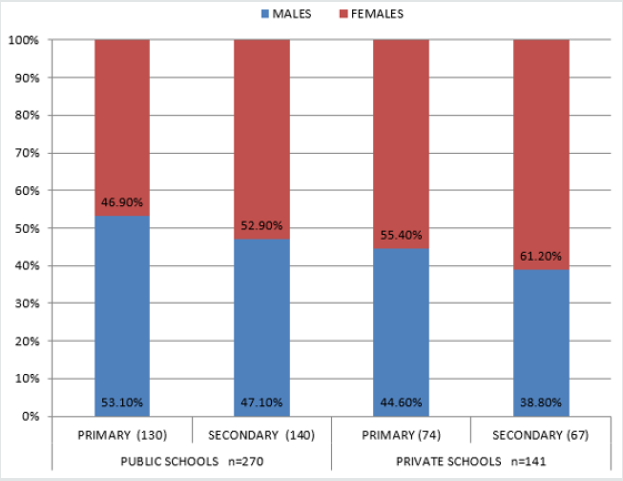
Four hundred and eleven students comprising 194 males and 217 females with a mean age of 12.5 (+2.6) participated in this study. Two hundred and four (49.6%) primary and 207 (50.4%) secondary school pupils participated in the study; 270 (65.7%) attended public schools while 141 (34.3%) attended private schools. Details in Figure 1. One hundred and eighty-three (44.5%) had history of previous dental injuries. Their responses to the questions on their knowledge of avulsion revealed that 323 (78.6%) would go to a dentist if they had tooth avulsion, 76 (18.5%) would see a medical doctor and 4 (1%) would go to the school clinic. Only 16 (3.9%) would replace the tooth in its socket. Although 164 (39.9%) would seek immediate treatment, 160 (38.9%) would take the tooth to the dentist. Two hundred and five (49.9%) would use normal saline as transport medium and only 22 (5.4%) would use milk. When avulsion occurs, 192 (46.7%) would throw it on roof top, while 160 (38.9%) would take the tooth to the dental clinic. Details in Table 1.
Gender of the subjects
When the gender was considered equal proportion of males and females would seek treatment from a dental clinic (78%) and immediate treatment within 15 minutes (40%). Though 40% of males and females would seek treatment within 15 minutes of the injury, there were statistically significant differences between the males and females (p=0.01) in their timing for seeking treatment (Table 2).
Table 2: The relationship between the Gender and knowledge to the process of tooth replantation.
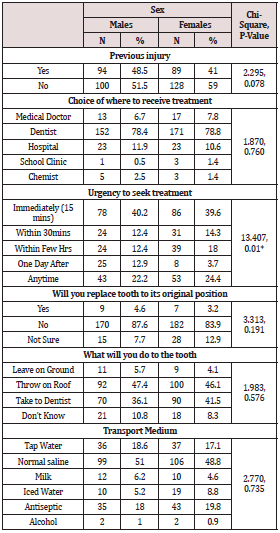
*p<0.05 is statistically significant
Private and public schools
Following avulsion, 4.8%public and 2.1%private school pupils would attempt replacing the tooth within the tooth socket at the site of injury. Three hundred and twenty-three (78.6%) would go to a dental clinic for treatment, however only 164 (39.9%) would seek dental treatment immediately after the injury. More (51.1%) public school pupils compared to 38%private pupils had cultural beliefs on throwing an avulsed tooth on roof tops (p=0.06). Twelve (4.4%) and 10 (7.1%) public and private school pupils, respectively would use milk as a transport medium while 63.8% private as against 42.6% public school pupils preferred normal saline as transport medium. There were statistically significant differences between the public and private school pupils on where to go for treatment (p=0.013) and transport media (p=0.00) following avulsion (Table 3).
Table 3: The relationship between the pupil’s school type and the knowledge of the process of tooth replantation.
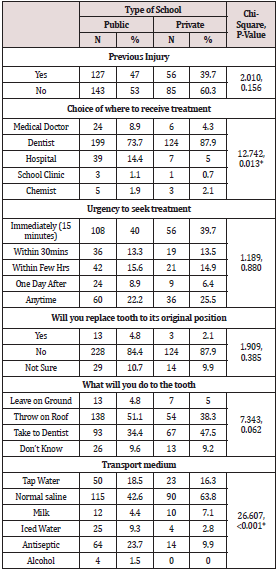
*p<0.05 is statistically significant
Level of education
Table 4 shows that 52.9% of primary school pupils and 44.9% secondary school pupils preferred normal saline while 7.4% of primary school pupils preferred milk compared to 3.4% secondary school pupils. There were statistically significant differences between the primary and secondary school pupils on replacing the avulsed tooth back to the sockets (p=0.03), transport media (p=0.00).
Table 4: The association between the type of school, knowledge of emergency dental care and the level of education of the pupils.
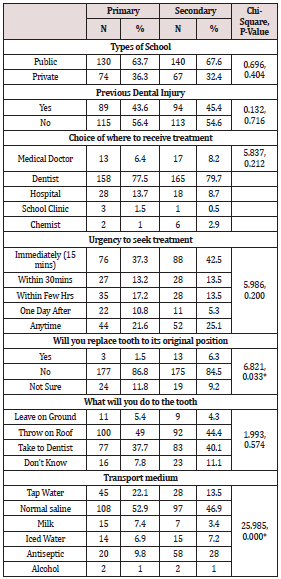
*p<0.05 is statistically significant
Discussion
Tooth avulsion is known to commonly occur among children in the mixed dentition phase hence the sample for this study was taken from among the school children. Though school children have teachers in the school premises, sometimes other pupils are the ones present when tooth avulsion occurs. The prognosis of treated avulsed tooth is dependent on prompt treatment which relies greatly on what is done at the site of the accident. Appropriate transport and storage media within the recommended period of storage will help maintain viability of the periodontal ligament cells, thus a favourable treatment outcome [18,19]. In this study 44.5% of the children had experienced dental trauma compared to 6-12.8% reported prevalence of TDI among the school aged children [15]. A good proportion (78.6%) of the participants would choose to receive treatment in a dental clinic. This demonstrates good awareness of whom a dentist is and understanding of the role a dentist plays in the healthcare. Such knowledge may have been fostered by series of outreaches and awareness programmes previously done in most of the schools [22]. However, there was a statistically significant difference in the level of knowledge between the private and public schools (p=0.013), the private school participants seem to know better. This finding is contrary to that reported in South Western Nigeria where the children preferred going to see a medical doctor thereby showing less awareness of the dentists’ role [24].
It was observed that 53.3% would seek professional care within 30 minutes after tooth injury, 23% may not seek care based on their choice of seeking care at “anytime”. This is a concern for a condition that requires urgent care and an off shoot of poor awareness of the importance of prompt treatment following dental trauma. The first aid measures at the site of injury include replacing the tooth in its original position [3,13] or placing in a suitable transport medium [13,18,19]. Only 16 (3.9%) would replace the tooth in its original position in the socket and there was statistically significant difference between the primary and secondary school pupils (p=0.03). This value is less than the 17.8% reported in the south west Nigeria [24]. When the gender and type of schools were considered there were no statistically significant differences between the males and females (p=0.19) and schools (p=0.39). There must be an understanding of tooth anatomy and most importantly there should be a formal teaching on what to do when tooth avulsion takes place. Though the most suitable transport medium listed was milk, [18,19] a good majority preferred normal saline, probably because normal saline appears more medicinal than milk. In this study it was observed that (46.7%) school children had a strong cultural belief on what should be done to a tooth that has been avulsed. This was shown by their response that they will throw the avulsed tooth on roof tops. This belief was commoner among pupils in public schools. The finding buttresses what was reported in a similar study in another geographical location within Nigeria with a different culture [24]. This belief stems from the myth that when a lizard sees an exfoliated tooth, that the succedaneous tooth would not erupt, so to prevent this from happening, the exfoliated teeth were thrown on roof tops away from the lizards [25]. The practice of throwing on roof tops has also been observed in some Asian countries like India, China, Japan, Korea, and Vietnam, although for different reasons [26]. The implication of this, is that the avulsed permanent tooth that would have had a chance of survival from replantation procedure in the dental clinic were being thrown away.
Conclusion
Traumatic dental injuries though a common occurrence amongst these school children (44.5%), their knowledge on first aid measures administered when tooth avulsion occurs before professional intervention is low. Although the children were aware of whom to see when they have dental injuries, the children still hold on to cultural beliefs which could be detrimental to the maintenance of the integrity of the dental arch hence oral health. These gaps in knowledge on first aid following tooth avulsion should be addressed by improving oral health education on traumatic dental injuries with emphasis on emergency care of tooth avulsion in schools. The curriculum on health education in schools should include oral care during dental emergencies.
Conflict of Interest
None of the authors have any conflicts of interest that should be disclosed.
References
- Max R, Ortiz Ospina E (2019) Primary and Secondary Education.Our World in Data, Africa.
- Eigbobo JO, Nzomiwu CL, Amobi EO, Etim SS (2014) The Standards of Playgrounds and Safety Measures in Prevention of Traumatic Dental Injuries in Nigerian Primary Schools. J West Afr Coll Sur 4(4): 82-99.
- Trabelsi K, Shephard RJ, Zlitni S, Omar Boukhris, Achraf Ammar et al. (2019) Dental Trauma First-Aid Knowledge and Attitudes of Physical Education Teachers: A Systematic Review and Meta-Analysis of the Literature with Meta-Regressions. Educ Sci 9(4): 251.
- Sari ME, Ozmen B, Koyuturk AE, Tokay U, Kasap P, et al. (2014) A Retrospective Evaluation of Traumatic Dental Injury in Children Who Applied to The Dental Hospital, Turkey. Niger J Clin Pract 17(5): 644-648.
- Eigbobo JO, Etim SS (2016) The Pattern of Traumatic Dental Injuries in Children in a Tertiary Health Care Facility in Nigeria. J Int Dent Med Res 9(1): 33-38.
- Oredugba FA, Nzomiwu C L (2015) Causes and Pattern of Traumatic Dental Injuries in Children Presenting for Care at a Tertiary Health Centre. J Int Dent Med Res 8: 40-45.
- Azami Aghdash S, Ebadifard Azar F, Pournaghi Azar F, Rezapour A, Moradi Joo M, et al. (2015) Prevalence, Etiology, And Types of Dental Trauma in Children and Adolescents Systematic Review and Meta-Analysis. Med J Islam Repub Iran 29(4): 234.
- Mesquita GC, Soares PBF, Moura CCG, Roscoe MG, Paiva SM, et al. (2017) A 12-Year Retrospective Study of Avulsion Cases in a Public Brazilian Dental Trauma Service. Braz Dent J 28(6): 749-756.
- Pujita C, Sivakumar Nuvvula, GS, Nirmala SVSG, Yamini V (2013) Informative Promotional Outcome on School Teachers’ Knowledge about Emergency Management of Dental Trauma. J Conserv Dent 16: 21-27.
- Uppal A, Thakur S, Singhal P, Chauhan D, Jayam C, et al. (2017) Knowledge, Attitude and Practice (Kap) of Teachers Regarding Dental Traumatic Injuries among School Children of Shimla City. RRJDS 5(1): 31-38.
- Diaz JA, Bustos L, Brandt AC, Fernandez BE (2010) Dental injuries among children and adolescents aged 1-15 years attending to public hospital in Temuco, Chile. Dent Traumatol 26(3): 254-261.
- Umanah AU, Eigbobo JO (2015) Tooth Loss Secondary to Iatrogenic Avulsion During Surgery an avoidable complication. Nigerian Hospital Practice 15(5-6): 75-78.
- Poi WR, Sonoda CK, Martins CM, Melo ME, Pellizzer EP, et al. (2013) Storage Media for Avulsed Teeth: A Literature Review. Braz Dent J 24(5): 437-445.
- Eigbobo JO, Nzomiwu CL, Etim SS, Amobi EO (2015) The Care of Traumatic Dental Injuries in Primary Schools in Southern Nigeria. Eur J Paed Dent 16(3): 197-200.
- Adekoya Sofowora C A, Bruimah R, Ogunbodede E O (2004) Traumatic Dental Injuries Experience in Suburban Nigerian Adolescents. Int J Dent Sci 3(1): 1-6.
- Savas S, Kucukyilmaz E, Akcay M, Koseoglu S (2015) Delayed Replantation of Avulsed Teeth: Two Case Reports. Case Rep Dent Article ID 197202.
- Sanu OO, Utomi IL (2005) Parental Awareness of Emergency Management of Avulsion of Permanent Teeth of Children in Lagos, Nigeria. Niger Postgrad Med J 12(2): 115-120.
- Adnan S, Lone MM, Khan FR, Hussain SM, Nagi SE (2018) Which is the Most Recommended Medium for the Storage and Transport of Avulsed Teeth? A Systematic Review. Dental Traumat 34(2): 59-70.
- Udoye CI, Jafarzadeh H, Abbott PV (2012) Transport Media for Avulsed Teeth: A Review. Aust Endod J 38(3): 129-136.
- Ali Abdulrahman Al Zaidi, Ahmed Ali Al asmari (2017) Knowledge of Teachers and Parents about Emergency Management of Dental Trauma in Qassim Province, Saudi Arabia. Int J Contemp Med Res 4(10): 2131-2138.
- Olatosi OO, Iwuala SO, Isiekwe GI, Oredugba FA, Adenaike AS, et al (2013) Knowledge and Attitude of Some Nigerian School Teachers on the Emergency Management of Avulsed Permanent Incisor. J West Afr Coll Surg 3(4): 30-52.
- Etim SS, Eigbobo JO (2017). Traumatic Dental Injuries: An Assessment of Knowledge of Emergency Care among a Group of School Teachers in Port Harcourt, Nigeria. Nig Q J Hosp Med 27(3): 890-897.
- kumar A, Mangla R, Dua P, Madan M, Saini S, et al. (2017) Knowledge, Attitude, and Practice of Elementary School Teachers Toward Emergency Management of Dental Trauma in Sirmaur District, Himachal Pradesh: A Questionnaire Study. Indian J Dent Sci 9: 194-197.
- Adekoya–Sofowora C, Oziegbe E, Ugboko V, Akinbade A (2008) Knowledge of First Aid Measures of Avulsion and Replantation of Teeth in Nigerian School Children. The Internet Journal of Dental Science 7 (1): 1-7.
- Andersson L, Al Asfour A, Al Jame Q (2006) Knowledge of First – Aid Measures of Avulsion and Replantation of Teeth: An Interview of 221 Kuwaiti School Children. Dental Traumatology 22(2): 57-65.
- (2020) Affiliated Dentists. Tooth Traditions. From Around the World.
Editorial Manager:
Email:
pediatricdentistry@lupinepublishers.com

Top Editors
-

Mark E Smith
Bio chemistry
University of Texas Medical Branch, USA -

Lawrence A Presley
Department of Criminal Justice
Liberty University, USA -

Thomas W Miller
Department of Psychiatry
University of Kentucky, USA -

Gjumrakch Aliev
Department of Medicine
Gally International Biomedical Research & Consulting LLC, USA -

Christopher Bryant
Department of Urbanisation and Agricultural
Montreal university, USA -

Robert William Frare
Oral & Maxillofacial Pathology
New York University, USA -

Rudolph Modesto Navari
Gastroenterology and Hepatology
University of Alabama, UK -

Andrew Hague
Department of Medicine
Universities of Bradford, UK -

George Gregory Buttigieg
Maltese College of Obstetrics and Gynaecology, Europe -

Chen-Hsiung Yeh
Oncology
Circulogene Theranostics, England -
.png)
Emilio Bucio-Carrillo
Radiation Chemistry
National University of Mexico, USA -
.jpg)
Casey J Grenier
Analytical Chemistry
Wentworth Institute of Technology, USA -
Hany Atalah
Minimally Invasive Surgery
Mercer University school of Medicine, USA -

Abu-Hussein Muhamad
Pediatric Dentistry
University of Athens , Greece

The annual scholar awards from Lupine Publishers honor a selected number Read More...




